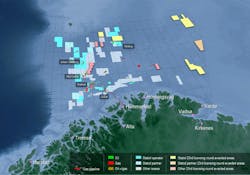Offshore staff
STAVANGER, Norway – Statoil looks set to drive a resurgence in exploration drilling offshore Norway next year.
Jez Averty, head of exploration on the Norwegian continental shelf (NCS), said at ONS today that the company planned to drill 17 exploratory wells across the Norwegian sector in 2017 and three in UK waters.
The program could include up to seven wells in theBarents Sea, five of which would be in previously undrilled regions. All are on prospects seen as among the most competitive in the company’s global portfolio, Averty said.
Unlike the company’s previous Barents Sea drilling campaign, focused entirely on prospects close to the Skrugard and Havis (Johan Castberg) fields, next year’s wells will be in different frontier areas. The thinking, he explained, is that if one proves disappointing, “it won’t wreck the entire program.”
Statoil will stick with these targets even if one of the wells delivers a potentially major discovery, added Tim Dodson, evp exploration.
Over the next few months the company will focus on drilling lower-risk, near-infrastructure targets in the Norwegian Sea, starting with the current well in the Njord area, followed by another on a prospect within reach of the Norne facilities.
The first well in the Barents Sea will likely be on the Blamann structure in the Goliat area, less than a year after Statoil secured the surrounding license. Next year’s higher-risk targets in the region will include wells on the Koigen Central structure in PL718, on the Stappen High, and on the Korpfjell prospect in Pl859, awarded inNorway’s recent 23rd licensing round.
Averty described Korpfjell as a “true wildcat,” which will also be Norway’s most northerly well to date, a record currently held byOMV’s Wisting oil discovery.
Three of the wells will pursue the same petroleum systems that delivered the Alta and Johan Castberg oil discoveries, he added.
Statoil has a semisubmersible rig,Songa Enabler, on a long-term contract that is capable of operating on the Barents Sea, Averty said. Conditions in the area are no harsher than the North Sea, he pointed out, and therefore suited to second- or third-generation semis.
Water depths range from 300-400 m (984-1,312 ft) – the main issues to contend with will likely be the shallow depths of the reservoirs.
Currently site surveys are under way, in cooperation with the authorities, to prepare for next year’s program. Statoil is anticipating typically $25 million for each of the wells, he said.
The company is also working on a further Barents Sea campaign, the targets for which will be independent of next year’s results.
The UK is a very mature petroleum province, Averty continued, “but that doesn’t mean we don’t think there is more to be found. We are looking to prove new geological ideas that could ultimately trigger new developments, with add-on potential.”
One of Statoil’s threeUK exploratory wells next year will be on a potentially large oil prospect in the P2170 license in the UK central North Sea – Statoil agreed to take a 70% operated interest in the concession last week.
08/30/2016



